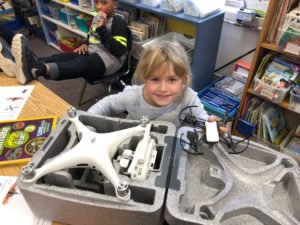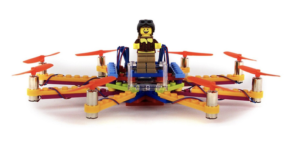The following is a guest post by talented Part 107 Pilot and author, Kara Murphy.
A few years back, I taught my daughter’s kindergarten class about drones. Of the eighteen kids in the class, only three had ever flown one with a parent and they were all boys. Flash forward two years, and of the twenty-four kids in her second grade class, twenty had flown one and only two girls had not. This is an accurate reflection of the explosive commercial growth over the past few years and the ratio has improved for a younger generation, as a result. Still, this doesn’t mean we shouldn’t stop short of getting kids involved with drones as often as possible.
Why Drones?
Drones are changing the world for the better. From making agriculture more efficient, aiding search-and-rescue operations, and delivering medicine to remote locations, to name a few useful applications, they deserve more credit for their positive impact than the media sometimes bestows upon them.
One of the numerous benefits UAVs offer developing young minds is increased cognitive development. An ideal tool for helping introduce kids to the fundamentals of STEM (Science, Technology, Engineering, and Math), maneuvering an unmanned aerial vehicle is a fun way to help them develop both problem solving and critical thinking skills without even realizing it.
What You Can Do
Getting started with teaching kids about the benefits of drones often involves a simple phone call or email to a teacher. An important question to ask is if you can demonstrate flying a drone to the class. While my daughter’s kindergarten teacher was fine with it, and even encouraged me to take a photo, her current school is structured in a way that getting a whole class out on to a field would be more time-consuming and impractical endeavor.
I structured my talk, complete with photos, around an introductory presentation, created in Keynote, covering the origin of drones (hint: bees are involved), how they differ from helicopters and airplanes, their various real-life uses, and safety tips. My strategy was to keep it simple, without overwhelming them with too much information, but plant a seed in the mind of what’s possible beyond flying in a park or backyard.
I brought in two drones to pass around: a Phantom 4 Pro, with the battery removed to completely ensure safety, and a Tello. The latter is something I highly recommend purchasing for your kid once they’ve demonstrated the ability to expertly maneuver and land their drone. I also distributed a worksheet with a few other options that are useful for practicing and even building. Here is what I recommend for kids interested in flying.
The Starter Drone
Holy Stone HS170 Predator Mini RC Helicopter Drone ($39.99)
Not just for kids but for any first-timers, this drone is perfect for getting the fundamentals down. I always like to purchase drones with prop guards, as well, to minimize damage if control of the drone is lost. This Holy Stone HS170 is lightweight, affordable, and extremely durable.
Learning Robotics
Flybrix (Starting at $149)
For the future builders who also enjoy snapping legos into place, Flybrix kits are for you. There are three different options, starting at $149. The best part? If you crash this drone, it’s easy to re-assemble and fly again. Not many drones boast this feature.
Indoor Fun
Inductrix FPV RTF or the Plus (Starting at $179)
A fellow Michigander, Chris Jeleniewski, introduced me to this line of drones that are perfect for indoor activities when temperatures drop over winter. Playing tiny whoop hide-and-seek with his kids is a favorite pastime. They feel like they’re playing a real-life video game.
The person who is “it” has to cover their eyes and the others fly to their hiding spot through the goggles, then that same person has to fly around and look for the hidden drones. The only precautionary measures necessary include ensuring toilets are closed and ceiling fans are turned off.
The Final Verdict
Despite descriptions claiming otherwise on some product pages, drones aren’t toys. If you have kids interested in flying, make sure you’re present whenever any type of drone is operated. Given all of the benefits of learning how to fly, including a jumpstart on getting acquainted with an industry that continues to innovate and grow, there’s no better time to get started than now.
Even though most of the girls in my daughter’s class knew about drones and had flown one, there is still a huge discrepancy in the industry. Only 5% of Part 107-certified pilots are women. Women Who Drone is looking to narrow the gap. Please consider donating to their crowdfunding campaign so they can work toward educating more women and girls.
Looking to educate yourself, study for the Part 107, or grow your own business? Drone U is offering access to their courses and community. It’s $1 for 14 days.
 Kara Murphy is a Part 107-certified commercial remote pilot and freelance writer residing in Michigan. Follow her aerial imagery on Instagram and learn more, here.
Kara Murphy is a Part 107-certified commercial remote pilot and freelance writer residing in Michigan. Follow her aerial imagery on Instagram and learn more, here.
https://dronelife.com/2018/11/02/getting-kids-excited-about-drones/
 Unmanned Aerial Vehicle The latest drone news
Unmanned Aerial Vehicle The latest drone news





